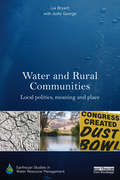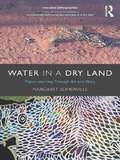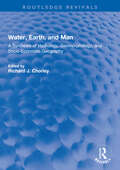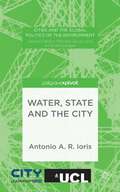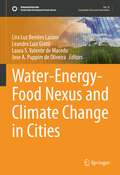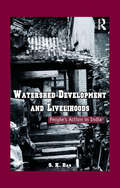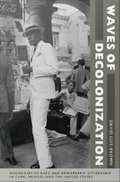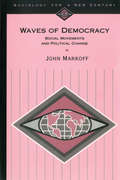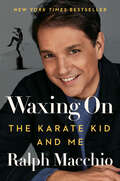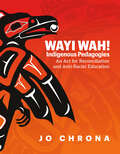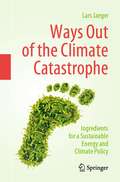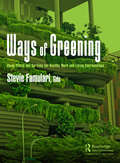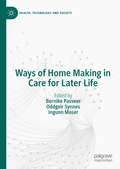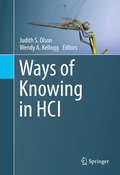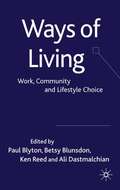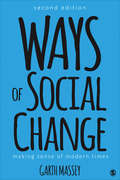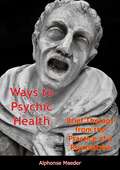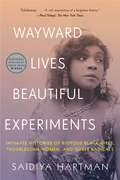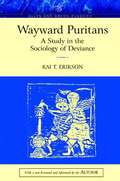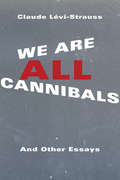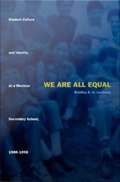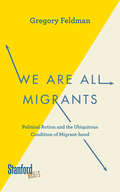- Table View
- List View
Water and Rural Communities: Local Politics, Meaning and Place (Earthscan Studies in Water Resource Management)
by Lia Bryant with Jodie GeorgeThe overall theme of this book concerns the multiplicity and complexities of discursive constructions of water in Western economies in relation to irrigation communities. The authors argue that the politics of place is given meaning in relation to local knowledges and within multiple and multiscalar institutional frameworks involved with the social, physical, economic and political practices associated with water. They are particularly concerned with water at the local level, including how it is exchanged, managed and given meaning. Using case studies from Australia and the United States of America, it is shown how water use and community relations, particularly during times of drought, are central to developing understandings about how communities challenge, adapt and respond to policy developments. The book also brings to light how unequal distribution of resources and risk conspicuously come to the surface during times of drought illustrating that water is a political subject occupying a unique position, moving between the natural and social worlds.
Water in a Dry Land: Place-Learning Through Art and Story
by Margaret SomervilleWater in a Dry Land is a story of research about water as a source of personal and cultural meaning. The site of this exploration is the iconic river system which forms the networks of natural and human landscapes of the Murray-Darling Basin, Australia. In the current geological era of human induced climate change, the desperate plight of the system of waterways has become an international phenomenon, a symbol of the unsustainable ways we relate to water globally. The Murray-Darling Basin extends west of the Great Dividing Range that separates the densely populated east coast of Australia from the sparsely populated inland. Aboriginal peoples continue to inhabit the waterways of the great artesian basin and pass on their cultural stories and practices of water, albeit in changing forms. A key question informing the book is: What can we learn about water from the oldest continuing culture inhabiting the world’s driest continent? In the process of responding to this question a team of Indigenous and non-Indigenous researchers formed to work together in a contact zone of cultural difference within an emergent arts-based ethnography. Photo essays of the artworks and their landscapes offer a visual accompaniment to the text on the Routledge Innovative Ethnography Series website, http://www.innovativeethnographies.net/. This book is perfect for courses in environmental sociology, environmental anthropology, and qualitative methods.
Water, Earth, and Man: A Synthesis of Hydrology, Geomorphology, and Socio-Economic Geography (Routledge Revivals)
by Richard J. ChorleyFirst published in 1969, Water, Earth, and Man, was written to demonstrate the advantages of adopting a unified view of the earth and social sciences. The book considers the connection between an understanding of physical environments and an understanding of social environments. It explores the hydrologic cycle and highlights the significance of the relationship between natural environments and the activities of humankind, drawing together physical and human geography to produce a highly detailed study.
Water, State and the City
by Antonio A. R. IorisThe book investigates the complexity of the Latin American mega cities and the multiple commitments of the apparatus of the state with a focus on the failures of the public water sector. It offers an innovative interpretation of large-scale urbanization, one of the most challenging questions affecting Latin American governments and society.
Water-Energy-Food Nexus and Climate Change in Cities (Sustainable Development Goals Series)
by Jose A. Puppim de Oliveira Leandro Luiz Giatti Lira Luz Benites Lazaro Laura S. Valente de MacedoThis book aims to contribute to the transdisciplinary study of the water-energy-food (WEF) nexus in cities and to help policy makers adopt a more integrated approach to natural resources management in urban environments to face the challenges and threats of climate change. This approach is based on a multidimensional scientific framework that seeks to understand the complex and non-linear interrelationships and interdependencies between water-energy-food under climate change and to generate solutions to reduce trade-offs among development goals and generate co-benefits that help encourage sustainable development and contribute to the achievement of SDGs, mainly SDG 11 (make cities and human settlements inclusive, safe, resilient and sustainable) and SDG 13 (take urgent action to combat climate change and its impacts).Governing the WEF nexus in cities is one of the greatest resource challenges of our time, as cities consume large amounts of WEF, but one that can also generate relevant alternatives with which to tackle climate change. To help fostering these alternatives, this book analyzes the governance, institutional and political economy factors that determine the effectiveness of the nexus approach and reviews the potential, the benefits and the policy implications of the adoption of the WEF nexus approach at the urban level. Through a series of hands-on cases, chapters in this book present the opportunities of the WEF nexus approach to achieve innovation and transformative change and discuss concrete areas of synergy and policy initiative to raise urban resilience. Water-Energy-Food Nexus and Climate Change in Cities will serve both as a guide for policy makers as well as a useful resource for students and researchers in fields such as urban studies, public health, environmental sciences, energy studies and public policy interested in learning how cities can represent possibilities to navigate and manage sustainability from local to global.
Watershed Development and Livelihoods: People’s Action in India
by S.K. DasThis book analyses the empowerment process of the Bhil as a result of the implementation of the watershed project in Jhabua. This visionary project, planned and implemented by the Bhil community, has put in place an integrated strategy that has given them control over their livelihood. It is examined against the backdrop of a framework that links three important aspects-biophysical (resource management and ecological balance), socio-economic (productivity, agricultural growth and livelihood support) and institutional (sustainable resource use, equity and benefit-cost sharing); and their complex interactions.
Waves of Decolonization: Discourses of Race and Hemispheric Citizenship in Cuba, Mexico, and the United States
by David Luis-BrownIn Waves of Decolonization, David Luis-Brown reveals how between the 1880s and the 1930s, writer-activists in Cuba, Mexico, and the United States developed narratives and theories of decolonization, of full freedom and equality in the shadow of empire. They did so decades before the decolonization of Africa and Asia in the mid-twentieth century. Analyzing the work of nationalist leaders, novelists, and social scientists, including W. E. B. Du Bois, Jos Mart, Claude McKay, Luis-Brown brings together an array of thinkers who linked local struggles against racial oppression and imperialism to similar struggles in other nations. With discourses and practices of hemispheric citizenship, writers in the Americas broadened conventional conceptions of rights to redress their loss under the expanding United States empire. In focusing on the transnational production of the national in the wake of U. S. imperialism, Luis-Brown emphasizes the need for expanding the linguistic and national boundaries of U. S. American culture and history. Luis-Brown traces unfolding narratives of decolonization across a broad range of texts. He explores how Mart and Du Bois, known as the founders of Cuban and black nationalisms, came to develop anticolonial discourses that cut across racial and national divides. He illuminates how cross-fertilizations among the Harlem Renaissance, Mexican indigenismo, and Cuban negrismo in the 1920s contributed to broader efforts to keep pace with transformations unleashed by ongoing conflicts over imperialism, and he considers how those transformations were explored in novels by McKay of Jamaica, Jess Masdeu of Cuba, and Miguel ngel Menndez of Mexico. Focusing on ethnography's uneven contributions to decolonization, he investigates how Manuel Gamio, a Mexican anthropologist, and Zora Neale Hurston each adapted metropolitan social science for use by writers from the racialized periphery.
Waves of Democracy: Social Movements and Political Change
by Professor John MarkoffWaves of Democracy looks at two centuries of history of democratization as a series of multicontinental episodes in which social movements and elite power holders in many countries converged to reorganize political systems. Democracy is defined and redefined in these episodes. John Markoff examines several ways in which governing elites of national states mimic each other and ways in which social movements and elites interact. There is no other book written for undergraduates that looks at democracy over such a broad sweep of time and across so many countries and cultures.
Waxing On: The Karate Kid and Me
by Ralph MacchioSince The Karate Kid first crane-kicked its way into the pop culture stratosphere in June 1984, there hasn’t been a week Ralph Macchio hasn’t heard friendly shouts of “Wax on, wax off” or “Sweep the leg!” Now, with Macchio reprising his role as Daniel LaRusso in the #1 ranked Netflix show Cobra Kai, he is finally ready to look back at this classic movie and give the fans something they’ve long craved. <p><p>The book will be Ralph Macchio’s celebratory reflection on the legacy of The Karate Kid in film, pop culture, and his own life. It will be a comprehensive look at a film that shaped him as much as it influenced the world. Macchio will share an insider's perspective of the untold story behind his starring role—the innocence of the early days, the audition process, and the filmmaking experience—as well as take readers through the birth of some of the film’s most iconic moments. <p><p>Ultimately, the book centers on the film itself, focusing on the reason that the characters and themes have endured in such a powerful way and how these personal experiences have impacted Macchio's life. It will bring readers back to the day they met Daniel LaRusso and Mr. Miyagi for the first time, but will also provide a fascinating lens into how our pasts shape all of us and how the past can come back to enrich one's life in surprising and wonderful ways. <p> <b>New York Times Bestseller</b>
Way Too Cool: Selling Out Race and Ethics
by Shannon WinnubstLife, liberty, and the pursuit of cool have informed the American ethos since at least the 1970s. Whether we strive for it in politics or fashion, cool is big business for those who can sell it across a range of markets and media. Yet the concept wasn't always a popular commodity. Cool began as a potent aesthetic of post-World War II black culture, embodying a very specific, highly charged method of resistance to white supremacy and the globalized exploitation of capital.Way Too Cool follows the hollowing-out of "coolness" in modern American culture and its reflection of a larger evasion of race, racism, and ethics now common in neoliberal society. It revisits such watershed events as the 1960s Civil Rights Movement, second-wave feminism, the emergence of identity politics, 1980s multiculturalism, 1990s rhetorics of diversity and colorblindness, 9/11, and Hurricane Katrina, as well as the contemporaneous developments of rising mass incarceration and legalized same-sex marriage. It pairs the perversion of cool with the slow erasure of racial and ethical issues from our social consciousness, which effectively quashes our desire to act ethically and resist abuses of power. The cooler we become, the more indifferent we grow to the question of values, particularly inquiry that spurs protest and conflict. This book sounds an alarm for those who care about preserving our ties to an American tradition of resistance.
Wayi Wah! Indigenous Pedagogies: An Act for Reconciliation and Anti-Racist Education
by Jo Chrona★ Starred selection for CCBC's Best Books Ideal for Teachers 2023!Now a National Best Seller! How can Indigenous knowledge systems inform our teaching practices and enhance education? How do we create an education system that embodies an anti-racist approach and equity for all learners? This powerful and engaging resource is for non-Indigenous educators who want to learn more, are new to these conversations, or want to deepen their learning. Some educators may come to this work with some trepidation. You may feel that you are not equipped to engage in Indigenous education, reconciliation, or anti-racism work. You may be anxious about perpetuating misconceptions or stereotypes, making mistakes, or giving offence. In these chapters, I invite you to take a walk and have a conversation with a good mind and a good heart. With over two decades in Indigenous education, author Jo Chrona encourages readers to acknowledge and challenge assumptions, reflect on their own experiences, and envision a more equitable education system for all. Each chapter includes reflection questions to help process the ideas in each chapter suggestions for taking action in both personal and professional spheres of influence recommended resources to read, watch, or listen to for further learning personal reflections and anecdotes from the author on her own learning journey voices of non-Indigenous educators who share their learning and model how to move into, and sit, in places of unknowing and discomfort, so we can examine our own biases and engage in this work in a good way Grounded in the First Peoples Principles of Learning, this comprehensive guide builds on Chrona&’s own experiences in British Columbia&’s education system to explore how to shape anti-racist and equitable education systems for all. Perfect for reading on your own or with your professional learning community!
Wayi Wah! Indigenous Pedagogies: An Act for Reconciliation and Anti-Racist Education
by Jo Chrona★ Starred selection for CCBC's Best Books Ideal for Teachers 2023!Now a National Best Seller! How can Indigenous knowledge systems inform our teaching practices and enhance education? How do we create an education system that embodies an anti-racist approach and equity for all learners? This powerful and engaging resource is for non-Indigenous educators who want to learn more, are new to these conversations, or want to deepen their learning. Some educators may come to this work with some trepidation. You may feel that you are not equipped to engage in Indigenous education, reconciliation, or anti-racism work. You may be anxious about perpetuating misconceptions or stereotypes, making mistakes, or giving offence. In these chapters, I invite you to take a walk and have a conversation with a good mind and a good heart. With over two decades in Indigenous education, author Jo Chrona encourages readers to acknowledge and challenge assumptions, reflect on their own experiences, and envision a more equitable education system for all. Each chapter includes reflection questions to help process the ideas in each chapter suggestions for taking action in both personal and professional spheres of influence recommended resources to read, watch, or listen to for further learning personal reflections and anecdotes from the author on her own learning journey voices of non-Indigenous educators who share their learning and model how to move into, and sit, in places of unknowing and discomfort, so we can examine our own biases and engage in this work in a good way Grounded in the First Peoples Principles of Learning, this comprehensive guide builds on Chrona&’s own experiences in British Columbia&’s education system to explore how to shape anti-racist and equitable education systems for all. Perfect for reading on your own or with your professional learning community!
Ways Out of the Climate Catastrophe: Ingredients for a Sustainable Energy and Climate Policy
by Lars JaegerFloods, species extinction, migration, droughts, super tornadoes - climate change is no longer a threat looming on the horizon but has long since become part of our everyday lives. Limiting the emerging and worsening climate changes is one of the most important challenges of our time.All human induced climate impacts can be traced back to a single factor: Energy. This book provides a comprehensive and readable introduction to the interplay between energy and climate, which also includes the fields of technology, economics, and politics. At the same time, the issue is highly complex and can only be understood in all its details by expert scientists, meaning that the facts are often poorly presented in the political discussion about climate. To put it simply: If we want to stop and even reverse the current climate trends, we need to find answers to the following three questions: · How exactly does our existing way of consuming energy affect the climate? · What options are there for generating energy without negative climate effects, and what do these mean for our lives? · What technological advances will directly help us to achieve this in future? In a non-alarmist yet entertaining manner, the book highlights the key determinants of global energy supply. Readers will come to appreciate the crucial facts about "energy and climate", will be up to date with the latest scientific and technological knowledge, and will understand the global political and economic framework that we need to consider when designing an appropriate future energy and climate policy. At the same time, the author conveys a clear and optimistic message: We already have the technical capabilities (which will be further enhanced in the future) to reverse the devastating climate trends without significantly limiting prosperity. The obstacles lie primarily in economic and political "constraints" and particular conflicts of interest. “A very important book that explains one of the most essential questions of our time - how we can master climate change by an energy transition - with scientific precision and clear words.” Georg Kell, founder and former Executive Director of the United Nations Global Compact
Ways of Greening: Using Plants and Gardens for Healthy Work and Living Surroundings
by Stevie FamulariThis book focuses on rethinking working and living spaces and understanding how "greening" can make them healthier and their occupants happier. It teaches how to see unique ideas for spaces and some of the materials needed to create the designs. Inspired by a study that states that 8% of a space needs to have plants in order to positively affect the air quality of the space, this book explores what that minimum would look like in spaces and how it can be done to existing spaces as well as to new site designs, greening both interiors and exteriors. Using the mathematical amount of 10% per square foot, the illustrations start at that quantity of greening and show how it can look. The sites selected are both public and private sites, as well as interior and exterior. As there are more modalities, needs, and locations where people now work, making sure that multiple types of spaces are designed for people’s success is more relevant than ever. This includes designs for more traditional offices, open-air offices, commercial spaces, homes, studios, and more. Ways of Greening: using Plans and Gardens for Healthy Work and Living Surroundings gives readers a way to not only understand greening but to understand how to see greening applied to their place. The two basic ways to see the spaces selected are existing spaces to which greening design is applied afterward and upcoming spaces in which greening design can be built directly into the space. The first type of retrofitting greening into existing spaces can also be combined with the second type of space (new designs). There are examples of both types throughout the book. Essentially, this book addresses ways in which business owners, residents, developers, architects, agencies, and others can integrate greening to improve the air quality and the quality of life with a green solution.
Ways of Home Making in Care for Later Life (Health, Technology and Society)
by Bernike Pasveer Oddgeir Synnes Ingunn MoserThis is a book on how home is made when care enters the lives of people as they grow old at home or in ‘homely’ institutions. Throughout the book, contributors show how home is a verb: it is something people do. Home is thus always in the making, temporal, contested, and open to negotiation and experimentation. By bringing together approaches from STS, anthropology, health humanities and health care studies, the book points to the importance of people's tinkerings and experiments with making home, as it is here that home is being made and unmade.
Ways of Knowing in HCI
by Judith S. Olson Wendy A. KelloggThis textbook brings together both new and traditional research methods in Human Computer Interaction (HCI). Research methods include interviews and observations, ethnography, grounded theory and analysis of digital traces of behavior. Readers will gain an understanding of the type of knowledge each method provides, its disciplinary roots and how each contributes to understanding users, user behavior and the context of use. The background context, clear explanations and sample exercises make this an ideal textbook for graduate students, as well as a valuable reference for researchers and practitioners. 'It is an impressive collection in terms of the level of detail and variety. ' (M. Sasikumar, ACM Computing Reviews #CR144066)
Ways of Living
by Paul BlytonThis international collection explores aspects of lifestyle and identity, societal influences on ways of living, the relevance of social networks and geographic communities for lifestyle choices, and the significance of organisational policies and practices for lifestyle outcomes.
Ways of Social Change: Making Sense of Modern Times
by Professor Garth M. MasseyThe world is at our fingertips, but understanding what is going on has never been more daunting. Garth Massey’s Ways of Social Change is a primer for making sense of both rapidly moving events and the cultural and structural forces on which social life is built, while teaching critical thinking skills needed to understand social change. With an approach that is fresh, timely, challenging, and engaging, Ways of Social Change shows students how social change is both a lived experience and the result of our actions in the world. It invites the reader into the realm of social science, where clarification, understanding, and inquiry provide for both informed opinions and a path to effective involvement. The core of the book focuses on five forces that powerfully influence the direction, scope and speed of social change: science and technology, social movements, war and revolution, large corporations, and the state. A concluding chapter encourages students to examine their own perspectives and offers ways to engage in social change, now and in their lifetime.
Ways of Social Change: Making Sense of Modern Times
by Professor Garth M. MasseyThe world is at our fingertips, but understanding what is going on has never been more daunting. Garth Massey’s Ways of Social Change is a primer for making sense of both rapidly moving events and the cultural and structural forces on which social life is built, while teaching critical thinking skills needed to understand social change. With an approach that is fresh, timely, challenging, and engaging, Ways of Social Change shows students how social change is both a lived experience and the result of our actions in the world. It invites the reader into the realm of social science, where clarification, understanding, and inquiry provide for both informed opinions and a path to effective involvement. The core of the book focuses on five forces that powerfully influence the direction, scope and speed of social change: science and technology, social movements, war and revolution, large corporations, and the state. A concluding chapter encourages students to examine their own perspectives and offers ways to engage in social change, now and in their lifetime.
Ways to Psychic Health: Brief Therapy from the Practice of a Psychiatrist
by Alphonse MaederA distinguished Swiss psychotherapist interprets, through the presentation of case histories, the effective work done with the mentally ill and presents a basis for spiritual and mental health.In this book, which was first published in its English translation in 1953, Dr. Alphonse Maeder has written a clear explanation of what he feels happens in the human personality that causes the whole pattern of life to be distorted—to become unharmonized and self-centred.“A PSYCHOTHERAPIST reports on the insights gleaned from his practice. This book is based upon medical experience. I have tried to present a true picture of what actually happens during the consultation. It is not so much a question of presenting the typical case material but of seeking to reproduce faithfully what occurs during the fascinating—and often anxious hours of dialogue between physician and patient.”—Dr. Alphonse Maeder
Wayward Lives, Beautiful Experiments: Intimate Histories Of Social Upheaval
by Saidiya HartmanWinner of the 2019 National Book Critics Circle Award in Criticism Winner of the PEN/John Kenneth Galbraith Award for Nonfiction Winner of the 2020 Judy Grahn Award for Lesbian Nonfiction Finalist for the Lambda Literary Award for Lesbian Memoir/Biography "Exhilarating…A rich resurrection of a forgotten history." —Parul Sehgal, New York Times Beautifully written and deeply researched, Wayward Lives, Beautiful Experiments examines the revolution of black intimate life that unfolded in Philadelphia and New York at the beginning of the twentieth century. In wrestling with the question of what a free life is, many young black women created forms of intimacy and kinship indifferent to the dictates of respectability and outside the bounds of law. They cleaved to and cast off lovers, exchanged sex to subsist, and revised the meaning of marriage. Longing and desire fueled their experiments in how to live. They refused to labor like slaves or to accept degrading conditions of work. Here, for the first time, these women are credited with shaping a cultural movement that transformed the urban landscape. Through a melding of history and literary imagination, Wayward Lives, Beautiful Experiments recovers these women’s radical aspirations and insurgent desires.
Wayward Puritans: A Study in the Sociology of Deviance
by Kai T. EriksonThis book uses the Puritan settlement in 17th-century Massachusetts as a setting in which to examine several ideas about deviant behavior in society. Combining sociology and history, Erikson draws on the records of the Bay Colony to illustrate the way in which deviant behavior fits in the texture of social life generally. The main argument of the book is that deviant forms of behavior are often a valuable resource in society, providing a point of contrast which is necessary for the maintenance of a coherent social order.
We Are All Cannibals: And Other Essays
by Claude Levi-Strauss Jane Marie Todd Maurice OlenderOn Christmas Eve 1951, Santa Claus was hanged and then publicly burned outside of the Cathedral of Dijon in France. That same decade, ethnologists began to study the indigenous cultures of central New Guinea, and found men and women affectionately consuming the flesh of the ones they loved. "Everyone calls what is not their own custom barbarism," said Montaigne. In these essays, Claude Lévi-Strauss shows us behavior that is bizarre, shocking, and even revolting to outsiders but consistent with a people's culture and context.These essays relate meat eating to cannibalism, female circumcision to medically assisted reproduction, and mythic thought to scientific thought. They explore practices of incest and patriarchy, nature worship versus man-made material obsessions, the perceived threat of art in various cultures, and the innovations and limitations of secular thought. Lévi-Strauss measures the short distance between "complex" and "primitive" societies and finds a shared madness in the ways we enact myth, ritual, and custom. Yet he also locates a pure and persistent ethics that connects the center of Western civilization to far-flung societies and forces a reckoning with outmoded ideas of morality and reason.
We Are All Equal: Student Culture and Identity at a Mexican Secondary School, 1988-1998
by Bradley A. U. LevinsonWe Are All Equal is the first full-length ethnography of a Mexican secondary school available in English. Bradley A. U. Levinson observes student life at a provincial Mexican junior high, often drawing on poignant and illuminating interviews, to study how the the school's powerful emphasis on equality, solidarity, and group unity dissuades the formation of polarized peer groups and affects students' eventual life trajectories. Exploring how students develop a cultural "game of equality" that enables them to identify--across typical class and social boundaries--with their peers, the school, and the nation, Levinson considers such issues as the organizational and discursive resources that students draw on to maintain this culture. He also engages cultural studies, media studies, and globalization theory to examine the impact of television, music, and homelife on the students and thereby better comprehend--and problematize--the educational project of the state. Finding that an ethic of solidarity is sometimes used to condemn students defined as different or uncooperative and that little attention is paid to accommodating the varied backgrounds of the students--including their connection to indigenous, peasant, or working class identities--Levinson reveals that their "schooled identity" often collapses in the context of migration to the United States or economic crisis in Mexico. Finally, he extends his study to trace whether the cultural game is reinforced or eroded after graduation as well as its influence relative to the forces of family, traditional gender roles, church, and global youth culture. We Are All Equal will be of particular interest to educators, sociologists, Latin Americanists, and anthropologists.
We Are All Migrants: Political Action and the Ubiquitous Condition of Migrant-hood
by Gregory FeldmanNow more than ever, questions of citizenship, migration, and political action dominate public debate. In this powerful and polemical book, Gregory Feldman argues that We Are All Migrants. By challenging the division between those considered "citizens" and "migrants," Feldman shows that both subjects confront disempowerment, uncertainty, and atomization inseparable from the rise of mass society, the isolation of the laboring individual, and the global proliferation of rationalized practices of security and production. Yet, this very atomization--the ubiquitous condition of migrant-hood--pushes the individual to ask an existential and profoundly political question: "do I matter in this world?" Feldman argues that for particular individuals to answer this question affirmatively, they must be empowered to jointly constitute the places they inhabit with others. Feldman ultimately argues that to overcome the condition of migrant-hood, people must be empowered to constitute their own sovereign spaces from their particular standpoints. Rather than base these spaces on categorical types of people, these spaces emerge only as particular people present themselves to each other while questioning how they should inhabit it.
